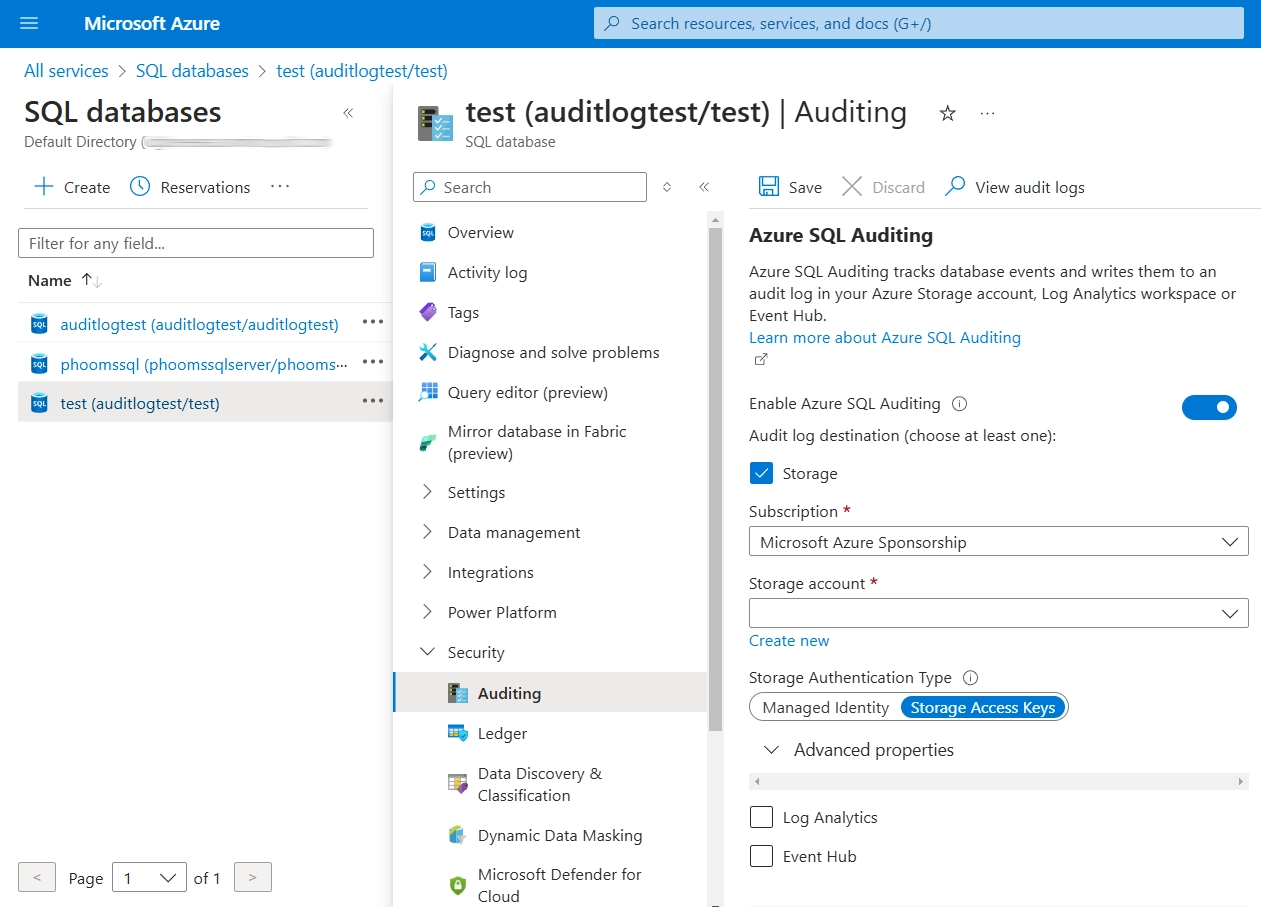What is Azure SQL Database Audit Trail
In today’s digital landscape, database security is paramount. According to the Microsoft Cyber Defense Report 2024, database breaches have increased by 56% in the past year, with inadequate audit trails identified as a major factor. Azure SQL Database audit trails provide a chronological record of database activities, documenting who accessed what data, when, and what actions they performed—essential for both security and compliance.
Understanding Azure SQL Database Audit Trail
An Azure SQL Database audit trail captures various database operations, including:
- Authentication attempts (successful and failed)
- Data manipulation operations (SELECT, INSERT, UPDATE, DELETE)
- Schema changes (CREATE, ALTER, DROP)
- Permission modifications (GRANT, DENY, REVOKE)
- Administrative actions
These audit trails serve multiple purposes:
- Security Monitoring: Detecting unauthorized access and potential threats
- Compliance Documentation: Meeting regulatory requirements (GDPR, HIPAA, SOX, PCI DSS)
- Forensic Investigation: Providing evidence for security incident analysis
- Operational Insights: Understanding database usage patterns
Native Azure SQL Database Audit Trail Capabilities
Azure SQL Database includes built-in audit capabilities that form the foundation of effective monitoring:
1. Azure SQL Database Auditing
This feature can be configured through the Azure portal, PowerShell, Azure CLI, or T-SQL commands:
# Enable auditing for an Azure SQL database
Set-AzSqlDatabaseAudit -ResourceGroupName "ComplianceRG" `
-ServerName "enterprise-sql-east" `
-DatabaseName "FinancialData" `
-State Enabled `
-StorageAccountName "auditlogs" `
-RetentionInDays 180 `
-AuditActionGroup @(
"SUCCESSFUL_DATABASE_AUTHENTICATION_GROUP",
"FAILED_DATABASE_AUTHENTICATION_GROUP",
"DATABASE_OPERATION_GROUP"
)
Example output:
ResourceGroupName : ComplianceRG
ServerName : enterprise-sql-east
DatabaseName : FinancialData
AuditState : Enabled
StorageAccountName: auditlogs
RetentionInDays : 180
AuditActionGroups : {SUCCESSFUL_DATABASE_AUTHENTICATION_GROUP,
FAILED_DATABASE_AUTHENTICATION_GROUP,
DATABASE_OPERATION_GROUP}
Audit logs can be sent to Azure Storage, Log Analytics, or Event Hub.
2. Sample Audit Trail Record
A typical record contains detailed information about database activity:
{
"event_time": "2025-02-18T15:42:36Z",
"action_id": "SELECT",
"server_principal_name": "finance_analyst@contoso.com",
"database_name": "FinancialReporting",
"object_name": "AnnualReports",
"statement": "SELECT * FROM AnnualReports WHERE FiscalYear = 2024",
"client_ip": "40.112.128.75"
}
3. Viewing Audit Logs in Azure Portal
The Azure Portal provides a simple web interface for exploring Azure SQL Database audit logs:
- Navigate to your SQL server or database in the Azure Portal
- Select “Auditing” under the Security section
- Click “View audit logs” to open the audit logs viewer

In the audit logs viewer, you can:
- Filter logs by time period, user, operation type, or status
- Search for specific text within query statements
- View detailed information for individual events
- Export filtered results for offline analysis
Limitations of Native Azure SQL Audit Trail
While native features provide essential functionality, they have limitations:
| Limitation | Impact |
|---|---|
| Limited real-time alerting | May delay detection of security incidents |
| Manual sensitive data classification | Critical information might remain unidentified |
| Basic reporting functionality | Challenges in demonstrating compliance to auditors |
| High storage costs | Significant expenses for long-term retention |
| Complex multi-database management | Inconsistent policies across environments |
| Limited behavioral analytics | Difficulty detecting sophisticated attack patterns |
Enhanced Audit Trails with DataSunrise
DataSunrise Database Security Suite extends Azure SQL Database’s native functionality with advanced features designed specifically for organizations with complex security and compliance requirements.
Key Advantages of DataSunrise
- Comprehensive Audit Rules: Create granular audit policies based on users, roles, applications, SQL commands, and even the content of queries. This level of detail allows organizations to focus their audit trails on high-risk operations while minimizing noise.
- Real-Time Monitoring: Monitor database activities as they happen with immediate alerts for suspicious actions. DataSunrise provides configurable notification channels including email, Slack, and MS Teams, enabling security teams to respond quickly to potential threats.
- Advanced Security Analytics: Leverage machine learning and user behavior analysis to establish normal activity patterns and automatically detect anomalies that might indicate security threats. This proactive approach helps identify sophisticated attacks that might bypass traditional security measures.
- Automated Compliance Reporting: Generate pre-configured reports for regulatory frameworks like GDPR, HIPAA, SOX, and PCI DSS with a single click. These automated reports significantly reduce the time and effort required for audit preparation and compliance documentation.
- Centralized Management Console: Manage audit policies across multiple Azure SQL instances and other database platforms through a unified interface. This centralized approach ensures consistent security controls and simplifies administration in complex environments.
Implementing DataSunrise for Azure SQL Audit Trails
Setting up DataSunrise for enhanced Azure SQL audit capabilities involves these straightforward steps:
- Connect to Azure SQL Database: Log in to DataSunrise’s web interface and add your Azure SQL Database with the appropriate connection details.
- Create Basic Audit Rule: Create a new audit rule for your Azure SQL instance and define which database objects to monitor.
- Configure Alert Notifications: Set up email or messaging platform integration with appropriate alert thresholds for real-time security monitoring.
- Monitor Audit Trails: Access comprehensive audit logs through the events dashboard with powerful filtering and reporting capabilities.

The entire implementation process typically takes less than a day, providing immediate visibility into database activities with minimal setup time.
Best Practices for Azure SQL Database Audit Trails
1. Performance Optimization
- Focus on auditing security-relevant operations
- Implement log rotation for older records
2. Security Implementation
- Protect audit logs from tampering
- Restrict access using role-based controls
- Encrypt audit data
3. Compliance Management
- Define clear retention policies
- Validate audit log completeness regularly
4. Monitoring and Analysis
- Establish review procedures
- Define baselines to identify anomalies
5. Enhanced Protection
- Implement DataSunrise for comprehensive audit trail capabilities beyond native features
- Leverage advanced analytics for proactive threat detection
Conclusion
A well-implemented Azure SQL Database audit trail is essential for security, compliance, and operational excellence. While native features provide a foundation, organizations with advanced requirements benefit from specialized solutions like DataSunrise that offer comprehensive database activity monitoring capabilities with real-time alerting, intelligent analytics, and automated reporting.
To explore enhanced Azure SQL Database audit trail solutions, consider scheduling an online demo of DataSunrise’s comprehensive security suite.
